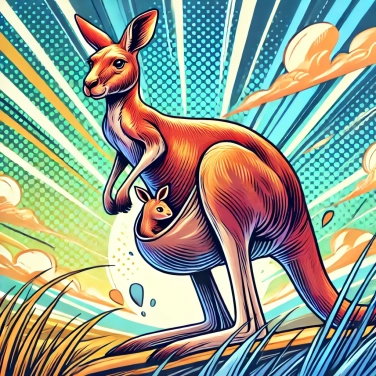Kangaroos have a pouch to protect and carry their young during their early development.

The kangaroo pouch, also called marsupium, primarily serves to protect and nourish the young, which are born prematurely and still fragile. In kangaroos, babies emerge from their mother's womb after just one month of gestation, incredibly tiny, without fur or sight. From the moment they are born, they immediately crawl from the birth canal into the pouch, instinctively following the scent to reach the teats. There, in this cozy and protective pouch, these babies continue to develop for several months, safe from predators, bad weather, and shocks. The pouch thus acts as a true mobile incubator, essential for supporting their early and fragile growth.
Marsupials like kangaroos come from a very ancient group that separated from other mammals about 160 million years ago. They initially lived in what would become South America, and then, taking advantage of the time when the continents were connected, they spread elsewhere, notably to Australia. There, isolated from all other mammals for a long time, the ancestors of kangaroos developed a different strategy to protect their young: the marsupial pouch. This pouch did not appear overnight but evolved slowly over generations through small successive adaptations. Those with a slightly larger skin fold or better protection for the young fared better, so their descendants logically inherited these advantages. Ultimately, the pouch allowed kangaroos to become particularly effective in harsh environments like those in Australia, where the ability to carry and protect their young was crucial for their survival.
In female kangaroos, the pouch (marsupium) is a sort of ventral pocket formed by a fold of soft skin, reinforced by powerful muscles. Inside, it is lined with soft, hairless skin, particularly rich in mammary glands that allow for feeding the young. Surprisingly, the opening of the pouch faces forward, towards the upper abdomen, preventing the baby kangaroo (the joey) from falling out when the mother moves by hopping or running. This expandable pouch grows with the young, providing enough space for the growing joey while protecting it from the elements, extreme temperatures, and potential external threats.
The pouch is a real little cocoon that keeps baby kangaroos (called joeys) warm and protected from the cold or bad weather. They are born very fragile, tiny, and almost in a fetal state, so this pouch provides them with warmth, protection, and direct access to their mother's milk through the nipples located inside. Safely protected from the outside, the little ones continue to grow quietly, in complete safety against their mother's skin. In this cozy refuge, they gain strength, develop their muscles, and gradually prepare their bodies for the outside world. When they feel strong enough, they start to make little excursions out of the pouch, while being able to return to it for refuge in case of danger. In short, the pouch is a true shelter, pantry, and mobile nest for these little kangaroos.
The marsupial pouch contains several glands that secrete antimicrobial substances. This protects the vulnerable baby kangaroos from bacterial infections during their growth.
Contrary to what one might think, the kangaroo's pouch is not a closed cavity: it has specific muscles that allow the mother to control its opening in order to secure or release the young ones when they wish to come in or out.
At birth, the tiny kangaroo is no bigger than a simple bean: it measures less than 3 centimeters and must crawl on its own to its mother's pouch, where it will complete its development.
The kangaroo can simultaneously carry two young in its pouch at different stages of development. Remarkably, the mother produces two different types of milk tailored to meet the specific nutritional needs of each of them.
A small kangaroo will first emerge from the pouch at around 6 or 7 months old. However, it will continue to return to the pouch regularly until about 8 to 10 months, after which it will gradually become independent.
Yes, baby kangaroos are born at a very early stage of their development. At birth, they are tiny, blind, hairless, and unable to survive on their own. They immediately crawl into their mother's pouch to continue growing, warm and safe.
The pouch did not appear suddenly, but gradually over the course of evolution. It provides a significant evolutionary advantage by ensuring better protection and nutrition for underdeveloped embryos at birth.
No, only female kangaroos have a pouch. It is used to protect and nourish the young kangaroos until they are mature enough to survive outside of the pouch.
No. Most marsupials do indeed have a pouch, but its shape, orientation, and depth vary considerably among species to adapt to their environment and way of life.

No one has answered this quiz yet, be the first!' :-)
Question 1/5